 |
 |
 |
| |
Plasma desmosine/isodesmosine and lung function
among people with or at risk of HIV infection
|
| |
| |
20th International Workshop on Comorbidities and Adverse Drug Reactions in HIV
Oct 13-14 NYC 2018
Reported by Jules Levin
Jing Sun, M. Bradley Drummond, Jacquie Astemborski, Shuren Ma, Xingjian Liu, Gerard M. Turino, Robert Brown, Gregory D. Kirk
October 13, 2018
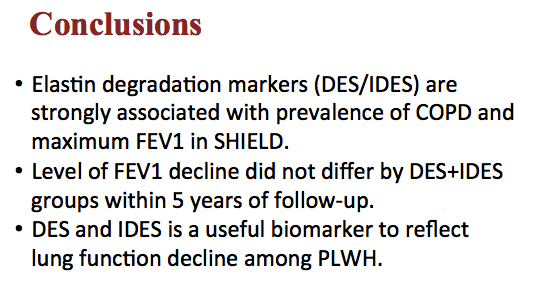
In conclusion, we observed elastin Elastin degradation markers (DES/IDES) are strongly associated with prevalence of COPD and maximum FEV1 in SHIELD. Level of FEV1 decline did not differ by DES+IDES groups within 5 years of follow-up.
We think DES and IDES is a useful biomarker to reflect lung function decline among PLWH.
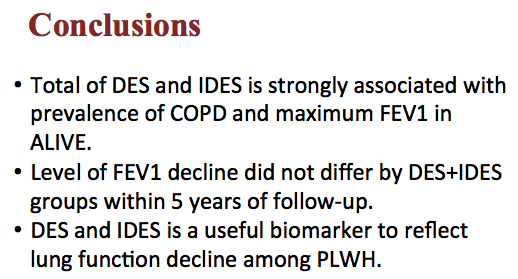
What is FEV1? Forced expiratory volume is measured during the forced vital capacity test. The forced expiratory volume in one second (FEV1) measurement shows the amount of air a person can forcefully exhale in one second of the FVC test.Feb 11, 2018
People living with chronic lung diseases, such as chronic obstructive pulmonary disease (COPD), emphysema and pulmonary fibrosis, often have their pulmonary function tested. Many doctors use lung function tests to help diagnose, monitor and treat chronic lung diseases. Lung function tests are also referred to as pulmonary function tests (PFTs). Two important measurements gained from pulmonary function tests are forced expiratory volume in one second (FEV1) and forced vital capacity (FVC). To help you better understand FEV1 and FVC, we’ve put together the important facts about what these measurements mean for you.
Forced expiratory volume in one second (FEV1) and forced vital capacity (FVC) are measured during a pulmonary function test. A diagnostic device called a spirometer measures the amount of air you inhale, exhale and the amount of time it takes for you to exhale completely after a deep breath. For pulmonary function tests, the spirometer attaches to a machine that records your lung function measurements.
What is FVC?
The forced vital capacity (FVC) measurement shows the amount of air a person can forcefully and quickly exhale after taking a deep breath.
Determining your FVC helps your doctor diagnose a chronic lung disease, monitor the disease over time and understand the severity of the condition. In general, doctors compare your FVC measurement with the predicted FVC based on your age, height and weight.
What is FEV1?
Forced expiratory volume is measured during the forced vital capacity test. The forced expiratory volume in one second (FEV1) measurement shows the amount of air a person can forcefully exhale in one second of the FVC test. In addition, doctors can measure forced expiratory volume during the second and third seconds of the FVC test.
Determining your FEV1 measurement helps your doctor understand the severity of disease. Typically, lower FEV1 scores show more severe stages of lung disease.
https://lunginstitute.com/blog/fev1-and-fvc/
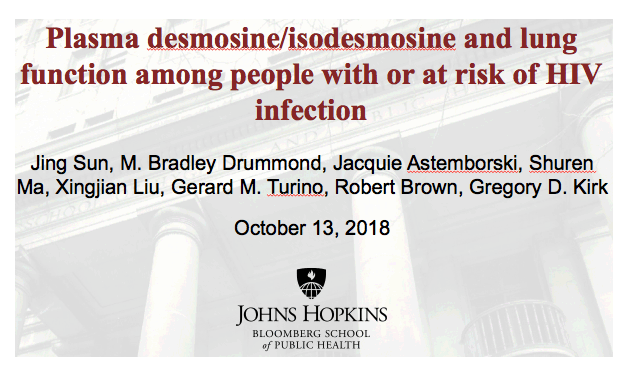
Incidence of chronic obstructive pulmonary disease and emphysema increased among PLWH, but the clinical manifestations and underlying mechanisms remain unclear. Previous studies suggested it might relate to chronic inflammation and higher smoking burden. A continuing issue for obstructive lung disease dx and tx is it has a long disease progression, but due to lack of sensitive parameters of lung injury and destruction, there is no sensitive short-term evaluation of disease progression.
Elastin fibers are part of the extracellular matrix and are an essential structural component of lung, skin, and blood vessels. The degradation of elastin-containing tissues could occur in several diseases, including chronic obstructive pulmonary disease (COPD). Previous study has proposed to use DES and IDES as a marker of elevated lung elastin degradation and as a biomarker for COPD or emphasema.
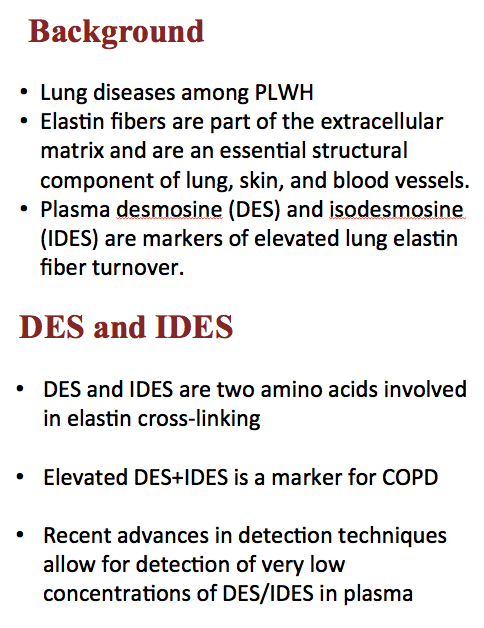
DES and IDES are two unique amino acids that serve as crosslinking molecules binding the chains of amino acids into the 3D network of elastin. They are useful for discriminating peptides derived from elastin breakdown from precursor elastin peptides. Increased excretion of DES/IDES in the urine and plasma is a marker of lung elastin fiber turnover. Previous studies suggested even a mild level of exacerbated lung function decline could be reflected in elevated level of DES/IDES.
Recent advances in detection techniques allow us to detect very low concentrations of DES+IDES in plasma. It is considered to be comparable to the urine DES/IDES measurement.
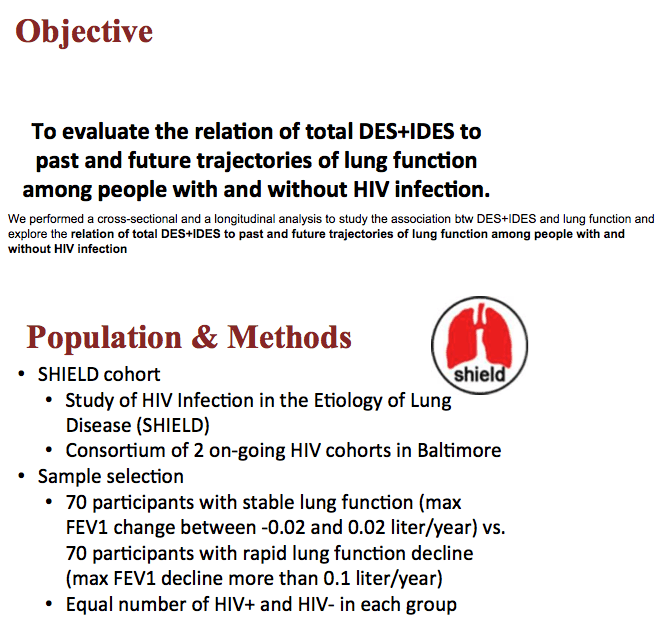
We performed a cross-sectional and a longitudinal analysis to study the association btw DES+IDES and lung function and explore the relation of total DES+IDES to past and future trajectories of lung function among people with and without HIV infection
We used SHIELD cohort is a consortium of multi-disciplinary investigators working with 2 on-going HIV cohorts in Baltimore to systematically evaluate the role of HIV in the development of non-infectious lung diseases, including COPD, lung cancer, and pulmonary arterial hypertension.
In the current study, among people with three year of observervation, we included 70 participants with stable lung function, which defined by maximum FEV1 change between +/- 20 ml per year, and 70 participants with rapid lung function decline, which defined by maximum FEV1 change more than 100 ml per year, at the end of the three year, we did the test of their plasma level of DES/IDES. Within the two groups, we included equal number of HIV+ and HIV- individuals.
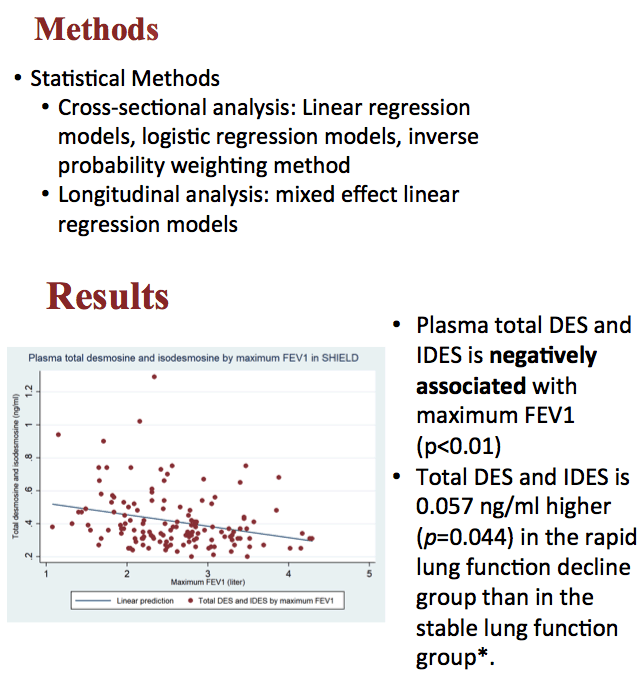
Among 140 participants in this study, the median age at baseline was 49
68% male, 95% black, 86% anti-HCV positive, 76% are current smokers, 24% of them has spirometry-confirmed OLD.
Plasma total DES/IDES is negatively associated with maximum FEV1 at baseline as demonostrated in this figure.
After inverse probability weighting on demographics, smoking (current, baseline pack-year), HIV status and recruitment cohort, we found that DES/IDES is 0.057 mg/ml higher among the rapid lung function decline group than that in the stable lung function group.
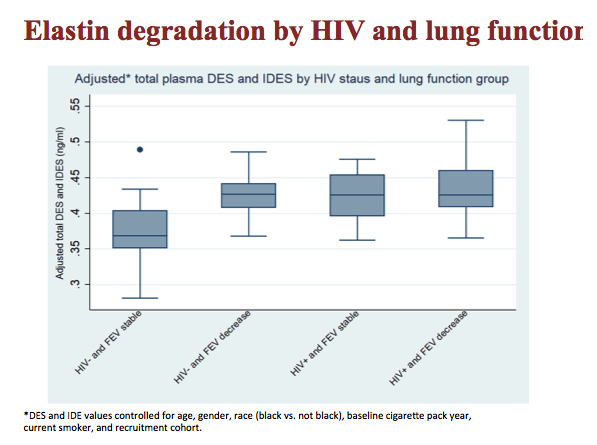
When we break down our sample into HIV serostatus and lung function, the difference of DES/IDES after controlled for demographics and smoking status is demonostrated as this figure. As we can see the HIV- and stable lung function group has the lowest level of total DES/IDES than any other groups. Although none of the difference reached statistical significant. What’s interesting here is the HIV+ and the stable lung function group has a similar predicted values in the total DES/IDES.
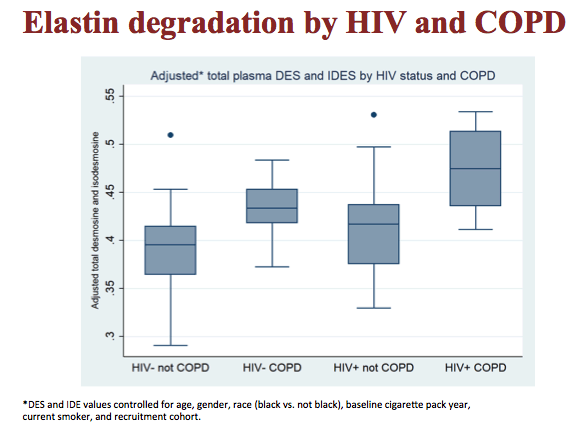
In this graphs, we broke down our population by HIV status and COPD. Compared to individuals without HIV and COPD, the total DES+IDES among individuals with HIV and COPD were 0.1 ng/ml higher (p=0.05) after controlling for covariates.
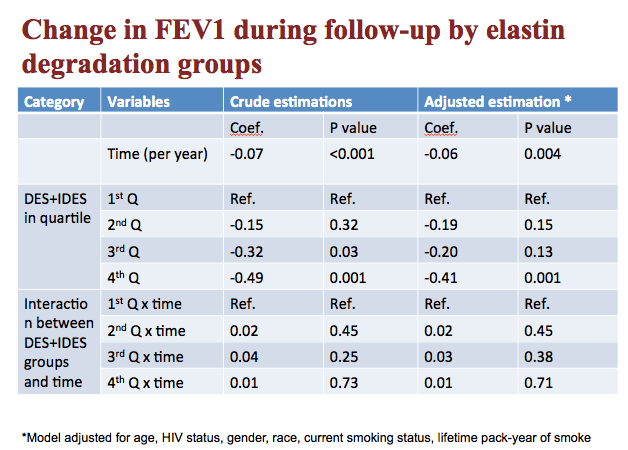
Next, we are interested in looking at whether or not level of DES/IDES predict the change in lung function decline over time. We constructed a mixed effect linear regression model to study the level of DES/IDES and its association with maximum FEV1 during follow-up. As presented in this table, after controlling for covariates, we observed FEV1 decline an average of 60 ml/year in the overall sample. Compared to the lowest quartile of total DES/IDES,the highest quartile was associated with a significant lower level of FEV1 at baseline. This difference in FEV1 was stable over time. We did not detect HIV effect in the analysis.
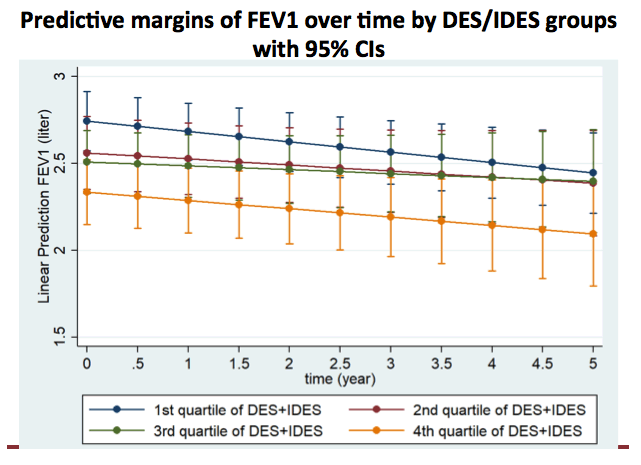
Here is a visualization of the previously presented model. The blue line indicates the lowest level of plasma DES/IDES and the orange line indicates the highest level of plasma DES/IDES. Again, the difference of FEV1 among these two groups was stable during the 5-year of followup.
When adjusting for cig-pack day and cohort, the p-value will move to 0.049 and achieve borderline significant
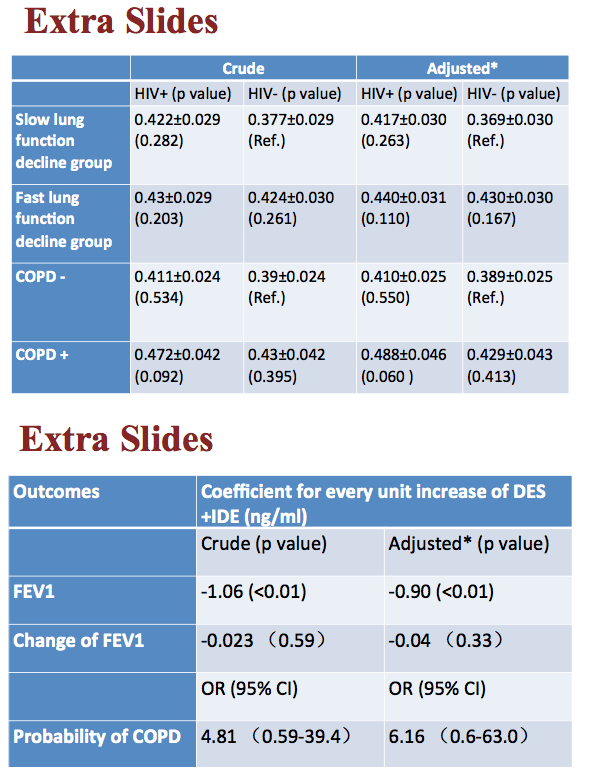
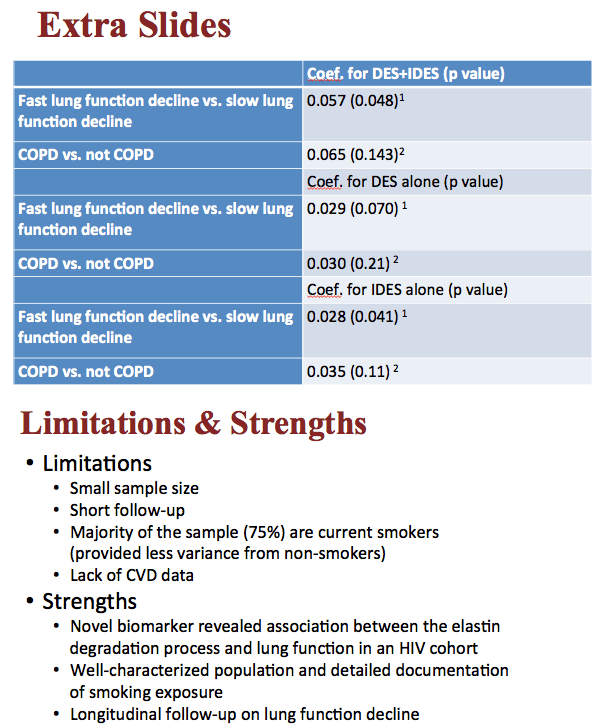
Our study has certain limitations: -Short follow-up: only about 5 yrs, so we are not able to predict the lung function decline when participants are much older
-Non-smoker: did not provide lung function decline among those who never been smoke
-CVD: elastin degradation could also appear in blood vessels, which could affect the level of DES+IDES. We lack of data to account for that.
Our study also has certain strengths. We use novel biomarker revealed the association between elastin degradation process and lung function in an HIV cohort. Benefiting from the two long lasting HIV cohorts, we have a well-characterized population with detailed documentation of participants’ smoking exposure, which allowed us to tease out the independent effect of HIV. We also have the longtidual follow-up data on lung function, which allows us to monitor their lung diseases progression.

|
| |
|
 |
 |
|
|